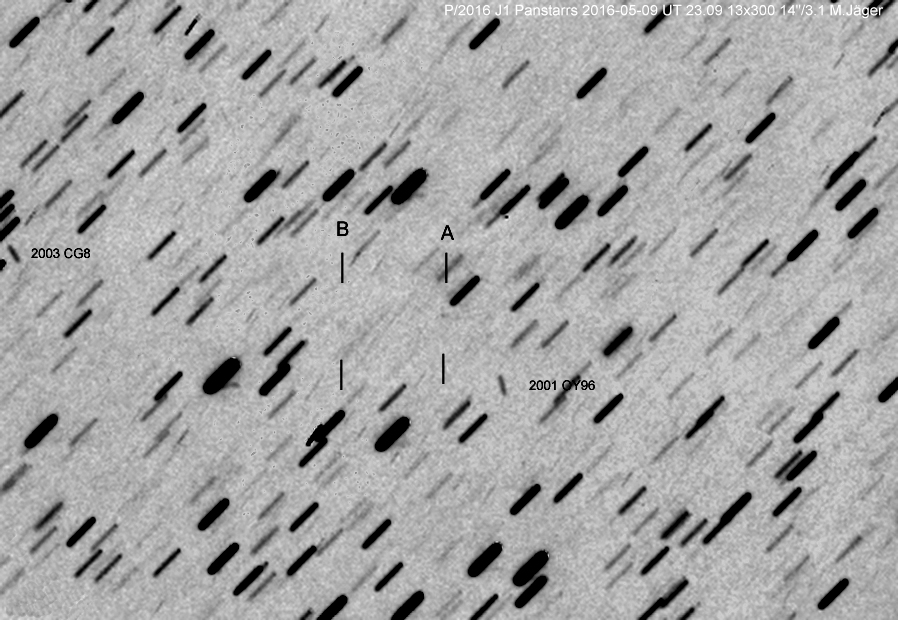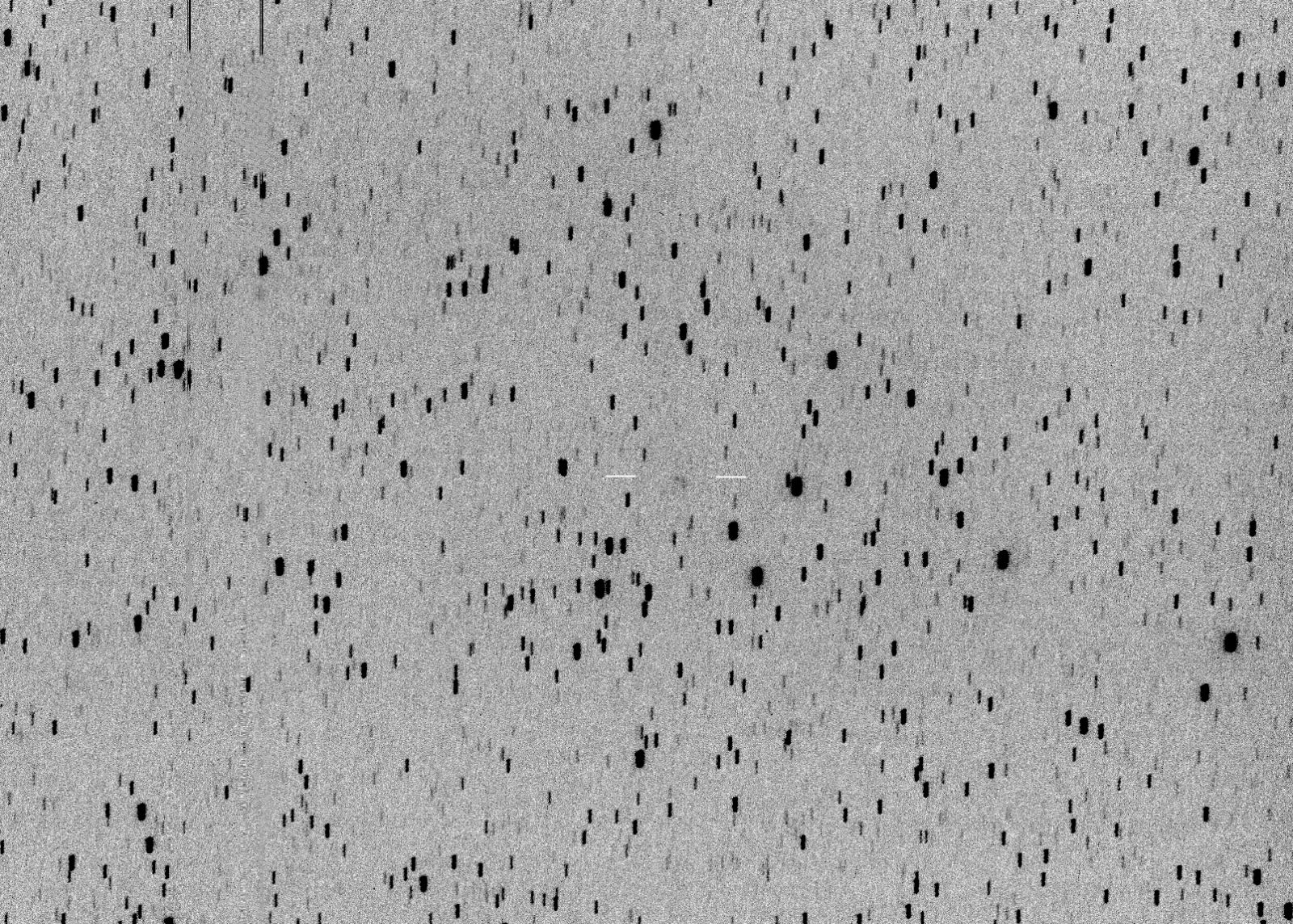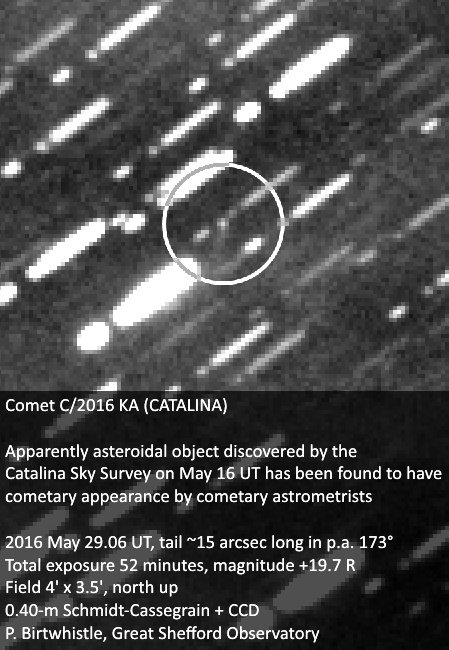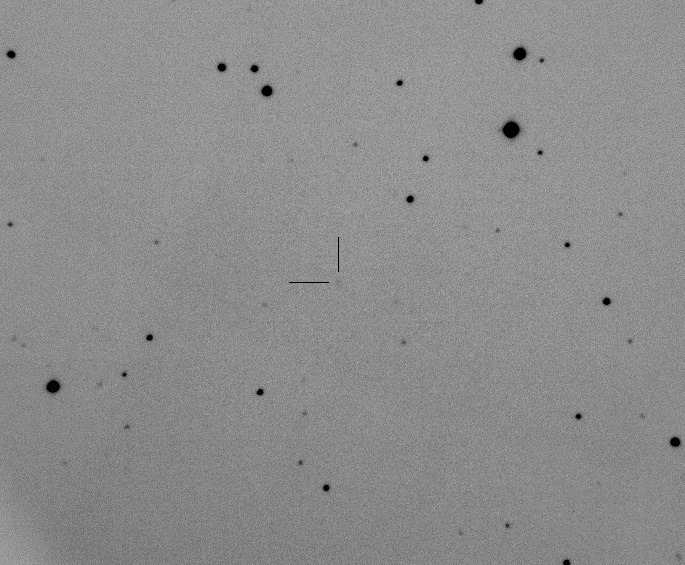Comets discovered in May 2016
P/2016 J1 (PANSTARRS)
R. Weryk and R. Wainscoat reported the discovery of an apparent comet in images obtained by PanSTARRS telescope on May 5.5 UT. The day after, Wainscoat at the 3.6-m Canada-France-Hawaii telescope noted a second comet in the field; the images of both comets were measured by M. Micheli (CBET 4276). Micheli notes that the two components are moving at nearly identical rates in nearly identical directions. The brighter component (designated component A) displays a clear and quite thin tail about 10" long in p.a. 250 deg in the May 6.43 images.
The fainter object (designated component B) also displays a clear but broader tail of similar length, oriented toward p.a. about 210 deg.
After the brighter component was posted on the Minor Planet Center' PCCP webpage, other CCD astrometrists also noted the cometary appearance of component A.
The available astrometry for both components and ephemerides appear on MPEC 2016-J90. The following preliminary orbital elements calculated by G. V. Williams for component A are from 24 observations spanning May 5-8:
T=2016 Aug. 25.5715
Peri =68.2929
Node = 197.8881
e = 0.254080
q = 2.326552 AU
Incl. = 13.4483
a = 3.119035 AU
n = 0.1789261
P = 5.51 years
Very preliminary elements for component B are based on those for component A, with T and Peri. modified:
T = 2016 Aug. 25.2149
Peri. = 68.2069
Node = 197.8881
e = 0.254080
q = 2.326552 AU
Incl. = 13.4483
a = 3.119035 AU
n = 0.1789261
P = 5.51 years

©M.Jager
C/2016 J2 (Denneau)
Larry Denneau, University of Hawaii, reports the discovery of a highly diffuse comet with the new ATLAS 0.5-m f/2.0 Schmidt telescope at Haleakala on May 6 (CBET 4277). M. Micheli, R. Wainscoat, and L. Wells confirming on May 7.3 UT the cometary nature.
After the object was posted on the Minor Planet Center's PCCP webpage, other CCD astrometrists around the world have commented on the object's cometary appearance.
The available astrometry (spanning May 6-8), the following preliminary parabolic orbital elements by G. V. Williams, and an ephemeris appear on MPEC 2016-J91:
T = 2016 Apr. 12.2902
Peri. = 318.7613
Node =186.2253
q = 1.519970 AU
Incl. = 130.2597
e= 1.0

©M.Jager
C/2016 KA (CATALINA)
An apparently asteroidal object discovered on CCD images taken by R. G. Matheny with the Catalina Sky Survey 0.68-m Schmidt telescope on May 16 UT and given the minor-planet designation 2016 KA (cf. MPEC 2016-K08). Peter Birtwhistle (England) has been found to have cometary appearance. (CBET 4280)
He took several images of the object on May 29.03/29.06 UT with his0.40-m f/6 Schmidt-Cassegrain telescope and appears to show cometary activity: while the nuclear condensation is essentially asteroidal, there is an apparent tail 15" long and 6" wide in p.a. 173 deg. Images taken by Birtwhistle on May 23.9 in strong moonlight showed only a hint of a 6” extension from the center of light, in p.a. 180 deg.
Elsewhere, K. Sarneczky and K. Vida, Konkoly Observatory, report that images taken with the 0.60-m Schmidt telescope at Piszkesteto, Hungary, on May 29.0 of 2016 KA shows a narrow, slightly curved, 20"-long tail at p.a. 170 deg; the coma appeared completely stellar.
G. V. Williams computed a preliminary orbit from 30 observations (spanning May 16-29 UT), and an ephemeris appear on MPEC 2016-K34.
T = 2016 Feb. 8.5549
Peri. = 63.9335
Node = 317.6408
q = 5.410662 AU
Incl. = 104.6461
e=1.0

P/2016 J3 STEREO Scott Ferguson has found a slightly diffuse comet with a short tail on HI-1 images taken with the STEREO-A spacecraft, with the object apparently fading from mag about 10 to mag about 13 over two days. Astrometry from COR-2 images was measured by Man-To Hui, and the positions tabulated below are geocentric positions computed from the first and last STEREO-A astrometry. Karl Battams, Naval Research Laboratory, adds that only COR-2 observations were measured astrometrically, as the HI-1 data are of such poor quality that it is doubtful that they would give any additional benefit; he also relates that the SOHO spacecraft did not observe this comet. Battams further notes that forward scattering may have played a major role in the comet's apparent brightness, as it was around mag 8 in the STEREO COR-2 images when nearer to the sun.
The reduced astrometry and the following uncertain elliptical orbital elements by G. V. Williams appear on MPEC 2016-K41:
T = 2016 May 21.4476 Peri. = 210.7379 Node = 259.0085 e = 0.880351 q = 0.466936 AU Incl. = 25.3299 a = 3.902562 AU n = 0.1278437 P = 7.71 years The orbital elements are extremely uncertain.
C/2016 K1 LINEAR
An apparently asteroidal object found on CCD images taken on May 31 in the course of the LINEAR survey, has been found to cometary appearance by CCD astrometrists (H.Sato, A. Gilmore, E. Guido and others) elsewhere after it was posted on the Minor Planet Center's NEOCP webpage. (CBET 4282)
The available astrometry, the following preliminary parabolic orbital elements by G. V. Williams (from 37 observations spanning May 31-June 4 UT), and an ephemeris appear on MPEC 2016-L34:
T =2016 July 14.3582
Peri.= 18.6617
Node =325.6983
q =2.288524 AU
Incl. = 90.9433
e=1.0

Image taken at Fujimi-machi, Nagano, Japan by Kunihiro Shima. Its magnitude is estimated as 17.3 by UCAC-4.
No results found.
